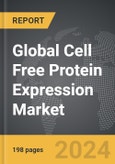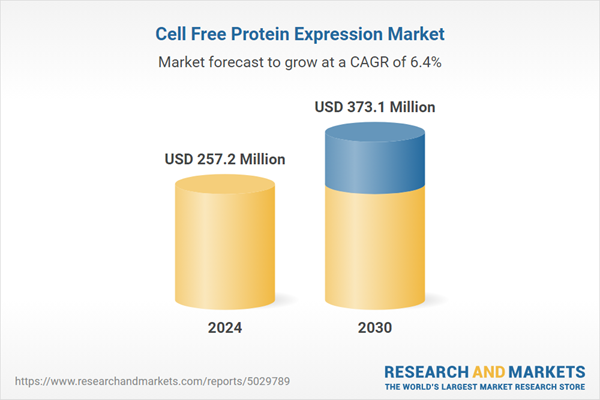The global market for Cell Free Protein Expression was valued at US$257.2 Million in 2024 and is projected to reach US$373.1 Million by 2030, growing at a CAGR of 6.4% from 2024 to 2030. This comprehensive report provides an in-depth analysis of market trends, drivers, and forecasts, helping you make informed business decisions.
Advancements in cell-free protein expression have significantly enhanced its capabilities, making it a versatile tool for a wide range of applications. Innovations in high-throughput screening and microfluidics have enabled researchers to express and analyze thousands of protein variants simultaneously, expediting the process of protein engineering and optimization. Moreover, improvements in the efficiency and robustness of cell-free systems have increased protein yields and reduced production costs, making the technology more accessible for both academic research and commercial applications. Cell-free protein expression is now being used extensively in synthetic biology for the rapid synthesis of proteins, including enzymes, antibodies, and other therapeutics. The technology also plays a critical role in drug discovery, allowing for the rapid prototyping of potential drug candidates and the study of protein interactions and functions in a highly controlled environment.
The growth in the cell-free protein expression market is driven by several factors. The increasing demand for personalized medicine and targeted therapies has fueled the need for rapid and flexible protein production systems that can accommodate the development of customized treatments. Advances in synthetic biology and genetic engineering have further driven the adoption of cell-free protein expression, as researchers seek efficient and scalable methods for protein synthesis and functional analysis. In the pharmaceutical and biotechnology sectors, the technology is being leveraged to accelerate drug discovery and development, enabling the rapid production and screening of large libraries of protein variants. Additionally, the rise of precision medicine and the growing need for specialized diagnostic tools have increased the demand for cell-free protein expression in clinical and research settings. Government and private sector investments in biotechnology infrastructure and innovation are also supporting market growth. These factors, coupled with ongoing technological advancements, are propelling the expansion of the cell-free protein expression market, solidifying its role as a vital component of modern biotechnological research and development.
Global Cell Free Protein Expression Market - Key Trends & Drivers Summarized
Cell-free protein expression is a cutting-edge technology that enables the synthesis of proteins without the use of living cells, by utilizing a mixture of cellular components extracted from organisms such as E. coli, wheat germ, or insect cells. This process involves combining these extracts with DNA or mRNA templates in a controlled in vitro environment, allowing for the direct translation of genetic information into functional proteins. One of the primary advantages of cell-free protein expression is its speed and efficiency, as it bypasses the time-consuming steps of cell culture and protein extraction. Additionally, this method allows for precise control over the reaction conditions, facilitating the production of proteins that might be toxic or difficult to express in live cells due to their complexity or instability.Advancements in cell-free protein expression have significantly enhanced its capabilities, making it a versatile tool for a wide range of applications. Innovations in high-throughput screening and microfluidics have enabled researchers to express and analyze thousands of protein variants simultaneously, expediting the process of protein engineering and optimization. Moreover, improvements in the efficiency and robustness of cell-free systems have increased protein yields and reduced production costs, making the technology more accessible for both academic research and commercial applications. Cell-free protein expression is now being used extensively in synthetic biology for the rapid synthesis of proteins, including enzymes, antibodies, and other therapeutics. The technology also plays a critical role in drug discovery, allowing for the rapid prototyping of potential drug candidates and the study of protein interactions and functions in a highly controlled environment.
The growth in the cell-free protein expression market is driven by several factors. The increasing demand for personalized medicine and targeted therapies has fueled the need for rapid and flexible protein production systems that can accommodate the development of customized treatments. Advances in synthetic biology and genetic engineering have further driven the adoption of cell-free protein expression, as researchers seek efficient and scalable methods for protein synthesis and functional analysis. In the pharmaceutical and biotechnology sectors, the technology is being leveraged to accelerate drug discovery and development, enabling the rapid production and screening of large libraries of protein variants. Additionally, the rise of precision medicine and the growing need for specialized diagnostic tools have increased the demand for cell-free protein expression in clinical and research settings. Government and private sector investments in biotechnology infrastructure and innovation are also supporting market growth. These factors, coupled with ongoing technological advancements, are propelling the expansion of the cell-free protein expression market, solidifying its role as a vital component of modern biotechnological research and development.
Scope of the Study
The report analyzes the Cell Free Protein Expression market, presented in terms of market value (US$ Thousand). The analysis covers the key segments and geographic regions outlined below.Segments:
Application (Protein-Protein Interaction, Protein Labeling, Enzyme Engineering, Protein Purification).Geographic Regions/Countries:
World; USA; Canada; Japan; China; Europe; France; Germany; Italy; UK; Rest of Europe; Asia-Pacific; Rest of World.Key Insights:
- Market Growth: Understand the significant growth trajectory of the Protein-Protein Interaction Application segment, which is expected to reach US$193.3 Million by 2030 with a CAGR of a 6.9%. The Protein Labeling Application segment is also set to grow at 5.6% CAGR over the analysis period.
- Regional Analysis: Gain insights into the U.S. market, valued at $121.9 Million in 2024, and China, forecasted to grow at an impressive 8.1% CAGR to reach $35.3 Million by 2030. Discover growth trends in other key regions, including Japan, Canada, Germany, and the Asia-Pacific.
Report Features:
- Comprehensive Market Data: Independent analysis of annual sales and market forecasts in US$ Million from 2024 to 2030.
- In-Depth Regional Analysis: Detailed insights into key markets, including the U.S., China, Japan, Canada, Europe, Asia-Pacific, Latin America, Middle East, and Africa.
- Company Profiles: Coverage of major players such as Agilent Technologies, Inc., Bio-Rad Laboratories, Inc., MilliporeSigma, AMS Biotechnology (Europe) Ltd. (amsbio), Bioneer Corporation and more.
- Complimentary Updates: Receive free report updates for one year to keep you informed of the latest market developments.
Why You Should Buy This Report:
- Detailed Market Analysis: Access a thorough analysis of the Global Cell Free Protein Expression Market, covering all major geographic regions and market segments.
- Competitive Insights: Get an overview of the competitive landscape, including the market presence of major players across different geographies.
- Future Trends and Drivers: Understand the key trends and drivers shaping the future of the Global Cell Free Protein Expression Market.
- Actionable Insights: Benefit from actionable insights that can help you identify new revenue opportunities and make strategic business decisions.
Key Questions Answered:
- How is the Global Cell Free Protein Expression Market expected to evolve by 2030?
- What are the main drivers and restraints affecting the market?
- Which market segments will grow the most over the forecast period?
- How will market shares for different regions and segments change by 2030?
- Who are the leading players in the market, and what are their prospects?
Some of the 34 major companies featured in this Cell Free Protein Expression market report include:
- Agilent Technologies, Inc.
- Bio-Rad Laboratories, Inc.
- MilliporeSigma
- AMS Biotechnology (Europe) Ltd. (amsbio)
- Bioneer Corporation
- Indivumed GmbH
- GeneCopoeia, Inc.
- Creative Biolabs
- GenScript Biotech Corporation
- Cube Biotech GmbH
- Jena Bioscience GmbH
- biotechrabbit GmbH
- CellFree Sciences Co., Ltd.
- Creative Biostructure
- Global Life Sciences Solutions USA LLC (Cytiva)
Table of Contents
I. METHODOLOGYMII. EXECUTIVE SUMMARY2. FOCUS ON SELECT PLAYERSIII. MARKET ANALYSISIV. COMPETITION
1. MARKET OVERVIEW
3. MARKET TRENDS & DRIVERS
4. GLOBAL MARKET PERSPECTIVE
UNITED STATES
CANADA
JAPAN
CHINA
EUROPE
FRANCE
GERMANY
ITALY
UNITED KINGDOM
REST OF EUROPE
ASIA-PACIFIC
REST OF WORLD
Companies Mentioned (Partial List)
A selection of companies mentioned in this report includes, but is not limited to:
- Agilent Technologies, Inc.
- Bio-Rad Laboratories, Inc.
- MilliporeSigma
- AMS Biotechnology (Europe) Ltd. (amsbio)
- Bioneer Corporation
- Indivumed GmbH
- GeneCopoeia, Inc.
- Creative Biolabs
- GenScript Biotech Corporation
- Cube Biotech GmbH
- Jena Bioscience GmbH
- biotechrabbit GmbH
- CellFree Sciences Co., Ltd.
- Creative Biostructure
- Global Life Sciences Solutions USA LLC (Cytiva)
Table Information
| Report Attribute | Details |
|---|---|
| No. of Pages | 198 |
| Published | April 2025 |
| Forecast Period | 2024 - 2030 |
| Estimated Market Value ( USD | $ 257.2 Million |
| Forecasted Market Value ( USD | $ 373.1 Million |
| Compound Annual Growth Rate | 6.4% |
| Regions Covered | Global |









